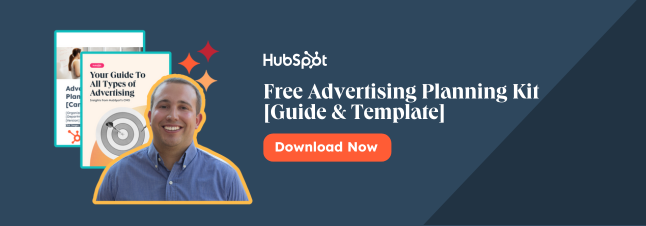Welcome to Creator Columns, where we bring expert HubSpot Creator voices to the Blogs that inspire and help you grow better.

Back in 2015, I worked for a medium-sized British software company. My job was to increase the number of leads we generated from our Facebook, Twitter, and LinkedIn accounts.
To help, I was handed around £5,000 and asked to create a few click-worthy Facebook ads.
Feeling a little short on inspiration, I Googled "best ads of all time."
Here’s what I saw.

The "Think small." ad is considered the best ad of the 20th century (Ad Age). It’s tremendous. It broke the norms for newspaper advertising with an overwhelming amount of white space that caught attention and challenged the industry norms, showcasing the car’s unusually small design as a benefit, not a drawback.
But it didn’t help me come up with a lead magnet Facebook ad. My ideas were lousy.
Turns out, staring at great ads didn’t help me create great ads.
Instead, I should have learned the psychology behind great ads, which can provide simple tips anyone can use to make an ad more effective.
.png)
Free Advertising Planning Kit
Plan and launch an effective and profitable advertising campaign with this guide and set of templates.
- An Overview of Popular Advertising Methods
- The Pros, Cons, and Costs of Advertising Types
- A Planning Template to Outline Timeline, Budget, and Goals
- A Project Pitch Presentation Deck to Share With Stakeholders
Download Free
All fields are required.
.png)
In the eight years since, I’ve interviewed dozens of ad experts on Nudge and now have three scientifically proven tactics I use whenever I’m creating an ad.
So, time to stop staring at the Volkswagen, and instead try following this simple advice.
Scientifically Proven Tactics for Creating an Ad (With Examples)
1. Create scarcity.
Back in 2019, KFC Australia ran a promotion. Chips for $1 across Australia.
To promote the offer, KFC devised a giant Facebook experiment. They created 90 different promotional messages, including creative copy like:
The Colonel has never been so generous, chips for a dollar.
Loved from Perth to Brisbane. They’re just $1.
Australia’s favorite chips for just $1.
All 90 different variations were published on Facebook ads in one mammoth experiment to see which was most effective.
Each of the ads was shown to thousands of Aussies, and the KFC team measured how many clicks each individual ad received.
The ad that won was deceivingly simple. It read:
"Chips for $1. Limited to four per customer."
Out of all 90 variations, this got the most clicks and drove the most sales. But why? KFC was limiting the promotion. KFC restricted the amount customers could buy.
So, why did it drive sales?
It’s due to scarcity.
By limiting the amount available, KFC made the chips seem like a scarce resource. We’re wired to prefer scarce resources over abundant resources.
When we read that the chips are limited to four per customer, we quickly assume the deal must be good — why else would KFC limit it?
This experiment shows that scarcity will often beat the most creative ad slogans.
So, with the ad you’re creating, try to add a bit of scarcity. Perhaps limit the amount a customer can buy. Maybe you should display low stock levels or a limited-time offer.
Do it ethically and truthfully and you’ll probably create a better ad.
2. Leave a letter out.
In a 2020 study by Leo Burnett, Mike Treharne, and Richard Shotton (cited in Richard’s book), participants were shown ads with brand names containing missing letters, for example, "HS_C."
It was obvious to readers that the bank was HSBC, but by removing one letter, the ad became more engaging. And thus more effective.
Shotton, Treharne, and Burnett found that brand names with missing letters were 14% more memorable.

This is due to the generation effect.
By removing one of the letters from the brand name, the viewer is forced to think to find the answer.
It’s not hard. Everyone in the study knew that the bank was HSBC, but that extra bit of engagement made the ad more effective.
The charity Cancer Research UK has applied this exact principle in some of their ads.
They ran this major billboard campaign.

It takes viewers just a second to discover the answer is OBESITY. But that extra bit of engagement made the ad more memorable.
The American Red Cross has found a smart way to apply this same bias.
They removed the letters A, B, and O from their ad to highlight the need for those blood types and create a memorable ad.

The jumbled slogan forces the viewer to pay attention and makes the ad more effective.
In the lab, it’s shown to boost memorability.
And I reckon, it’s worth testing out yourself in your ads.
Try using incomplete brand names in your marketing materials, introduce quizzes or puzzles in your ad design, or test an interactive ad format that requires some form of user input.
It’s proven to make your ad more memorable.
Read more:
3. Ask a question.
Rohini Ahluwalia and Robert Burnkrant in their 2004 study showed several hundred participants dozens of different ads.
Ahluwalia and Burnkrant wanted to see if certain types of language made for more effective advertising copy.
They found that ads with questions in the copy were rated 14% more favorably than ads without a question.

Simply adding a question mark made the ad more engaging.
The two researchers hypothesized that audiences feel more connected to an ad when it poses a question.
The questions engage the audience, making the ad more effective.
A few years back I tested this exact Nudge ad.
I ran two Reddit ads.
The first ad (the control) had no question attached.
It said, "Ditch boring business podcasts. Try Nudge." Next to that copy, I put a few of my 5-star reviews.
The second ad was identical to the first, except, I added a question.
"Bored of boring business podcasts? Try Nudge."
I found that Ahluwalia and Burnkrant’s finding was real.
The ad with the question was 17% more effective than the control ad.

It drove far more people to my podcast and resulted in many more listeners.
A 17% improvement from changing just two words and adding a question mark is impressive. It shows that questions engage viewers — and they make an ad more effective.
These three tips won’t help you create an award-winning ad. They won’t spark the same creativity behind Volkswagen's "Think small." campaign.
But they will improve your ads. And, they’re simple, actionable steps you can use on any ad to nudge it that bit closer to perfection.
This blog is part of Phill Agnew’s Marketing Cheat Sheet series where he reveals scientifically proven tips to help you improve your marketing. To learn more, listen to his podcast Nudge, a proud member of the HubSpot Podcast Network.











![How to Create Banner Ads That Get Results: A 10-Step Guide [Free Ebook]](http://53.fs1.hubspotusercontent-na1.net/hubfs/53/banner_ads-1.jpg)
![Are Display Ads Worth Your Time? [Flowchart]](http://53.fs1.hubspotusercontent-na1.net/hubfs/53/display-ads.jpg)